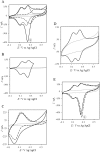Electron transfer in an acidophilic bacterium: interaction between a diheme cytochrome and a cupredoxin
- PMID: 29910941
- PMCID: PMC5982212
- DOI: 10.1039/c8sc01615a
Electron transfer in an acidophilic bacterium: interaction between a diheme cytochrome and a cupredoxin
Abstract
Acidithiobacillus ferrooxidans, a chemolithoautotrophic Gram-negative bacterium, has a remarkable ability to obtain energy from ferrous iron oxidation at pH 2. Several metalloproteins have been described as being involved in this respiratory chain coupling iron oxidation with oxygen reduction. However, their properties and physiological functions remain largely unknown, preventing a clear understanding of the global mechanism. In this work, we focus on two metalloproteins of this respiratory pathway, a diheme cytochrome c4 (Cyt c4) and a green copper protein (AcoP) of unknown function. We first demonstrate the formation of a complex between these two purified proteins, which allows homogeneous intermolecular electron-transfer in solution. We then mimic the physiological interaction between the two partners by replacing one at a time with electrodes displaying different chemical functionalities. From the electrochemical behavior of individual proteins, we show that, while electron transfer on AcoP requires weak electrostatic interaction, electron transfer on Cyt c4 tolerates different charge and hydrophobicity conditions, suggesting a pivotal role of this protein in the metabolic chain. The electrochemical study of the proteins incubated together demonstrates an intermolecular electron transfer involving the protein complex, in which AcoP is reduced through the high potential heme of Cyt c4. Modelling of the electrochemical signals at different scan rates allows us to estimate the rate constant of this intermolecular electron transfer in the range of a few s-1. Possible routes for electron transfer in the acidophilic bacterium are deduced.
Figures













Similar articles
-
Beyond the coupled distortion model: structural analysis of the single domain cupredoxin AcoP, a green mononuclear copper centre with original features.Dalton Trans. 2024 Jan 23;53(4):1794-1808. doi: 10.1039/d3dt03372d. Dalton Trans. 2024. PMID: 38170898 Free PMC article.
-
A new iron-oxidizing/O2-reducing supercomplex spanning both inner and outer membranes, isolated from the extreme acidophile Acidithiobacillus ferrooxidans.J Biol Chem. 2008 Sep 19;283(38):25803-11. doi: 10.1074/jbc.M802496200. Epub 2008 Jul 16. J Biol Chem. 2008. PMID: 18632666 Free PMC article.
-
Mineral respiration under extreme acidic conditions: from a supramolecular organization to a molecular adaptation in Acidithiobacillus ferrooxidans.Biochem Soc Trans. 2012 Dec 1;40(6):1324-9. doi: 10.1042/BST20120141. Biochem Soc Trans. 2012. PMID: 23176476 Review.
-
Insight into molecular stability and physiological properties of the diheme cytochrome CYC41 from the acidophilic bacterium Acidithiobacillus ferrooxidans.Biochemistry. 2005 May 3;44(17):6471-81. doi: 10.1021/bi048425b. Biochemistry. 2005. PMID: 15850381
-
In situ absorbance measurements: a new means to study respiratory electron transfer in chemolithotrophic microorganisms.Adv Microb Physiol. 2020;76:81-127. doi: 10.1016/bs.ampbs.2020.01.003. Epub 2020 Feb 5. Adv Microb Physiol. 2020. PMID: 32408948 Review.
Cited by
-
The structure of the diheme cytochrome c4 from Neisseria gonorrhoeae reveals multiple contributors to tuning reduction potentials.J Inorg Biochem. 2024 Apr;253:112496. doi: 10.1016/j.jinorgbio.2024.112496. Epub 2024 Jan 24. J Inorg Biochem. 2024. PMID: 38330683 Free PMC article.
-
Electrochemical and structural characterization of recombinant respiratory proteins of the acidophilic iron oxidizer Ferrovum sp. PN-J47-F6 suggests adaptations to the acidic pH at protein level.Front Microbiol. 2024 Feb 7;15:1357152. doi: 10.3389/fmicb.2024.1357152. eCollection 2024. Front Microbiol. 2024. PMID: 38384274 Free PMC article.
-
Beyond the coupled distortion model: structural analysis of the single domain cupredoxin AcoP, a green mononuclear copper centre with original features.Dalton Trans. 2024 Jan 23;53(4):1794-1808. doi: 10.1039/d3dt03372d. Dalton Trans. 2024. PMID: 38170898 Free PMC article.
-
Applications of chitosan (CHI)-reduced graphene oxide (rGO)-polyaniline (PAni) conducting composite electrode for energy generation in glucose biofuel cell.Sci Rep. 2020 Jun 26;10(1):10428. doi: 10.1038/s41598-020-67253-6. Sci Rep. 2020. PMID: 32591600 Free PMC article.
References
-
- Quatrini R., Johnson D. B. Curr. Opin. Microbiol. 2018;43:139–147. - PubMed
-
- Cardenas J. P., Quatrini R., Holmes D. S. Res. Microbiol. 2016;167:529–538. - PubMed
-
- Ferguson S. J., Ingledew W. J. Biochim. Biophys. Acta. 2008;1777:1471–1479. - PubMed
-
- Roger M., Castelle C., Guiral M., Infossi P., Lojou E., Giudici-Orticoni M. T., Ilbert M. Biochem. Soc. Trans. 2012;40:1324–1329. - PubMed
LinkOut - more resources
Full Text Sources
Other Literature Sources
Miscellaneous

